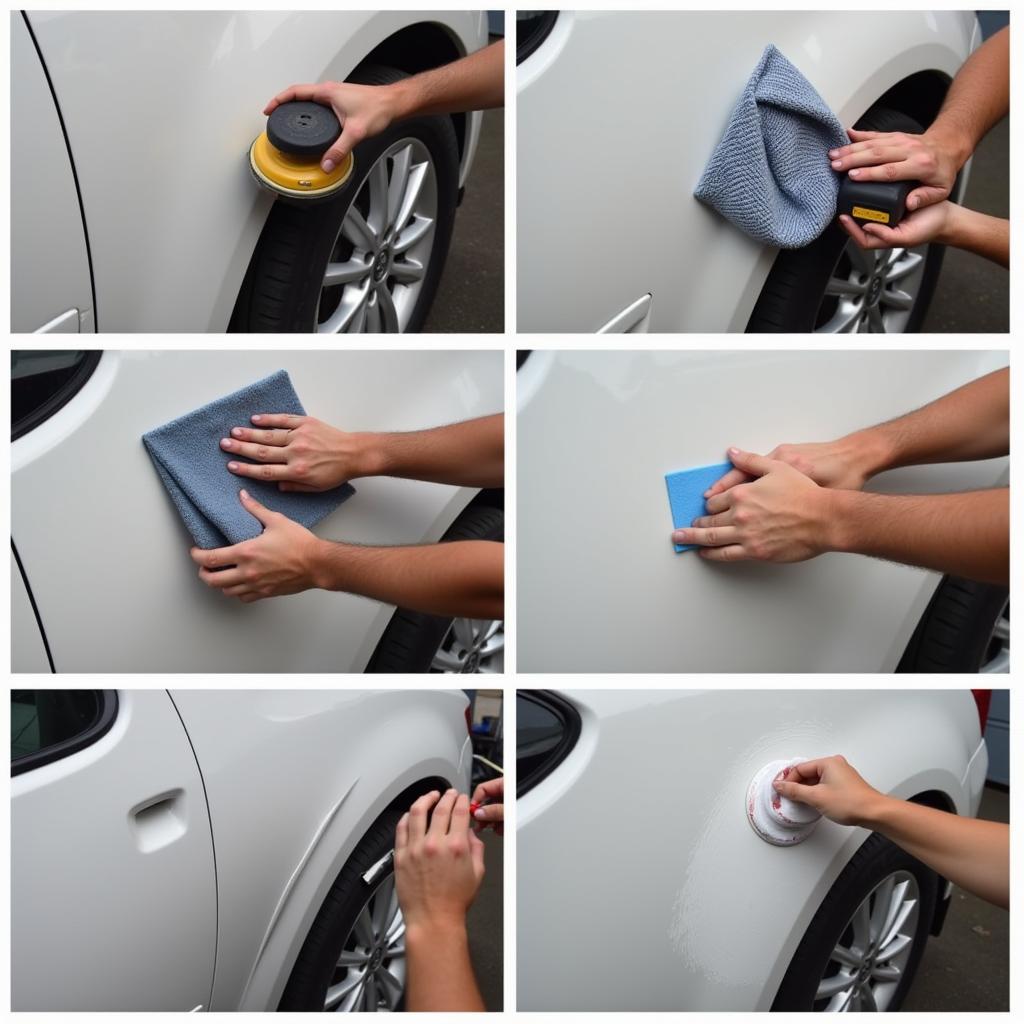Fixing a flat car tire is a common roadside problem, and knowing the best way to handle it can save you time, money, and potential danger. Whether you’re a seasoned mechanic or a new driver, understanding the intricacies of tire repair is crucial. This guide explores everything from identifying a flat to choosing the best tools and techniques for fixing it, ensuring you’re back on the road safely and efficiently.
After confirming you have a flat, safety is paramount. Pull over to a safe, level location away from traffic. Turn on your hazard lights and engage the parking brake. fixing cars pixel art can sometimes trivialize the real-world dangers associated with roadside repairs, so always prioritize safety.
Identifying and Assessing the Damage
Before you start fixing your flat tire, you need to understand the extent of the damage. A simple puncture can often be repaired with a plug or patch, while a blowout might require a full tire replacement. Inspect the tire carefully for visible damage, such as nails, screws, or sidewall tears. Check the tire pressure to confirm it’s significantly lower than normal.
What are the common causes of flat tires?
Common culprits include sharp objects like nails and screws, potholes, and even worn-out tires. Regularly checking your tire pressure and tread depth can help prevent flats in the first place.
Gathering the Right Tools: Your Flat Tire Toolkit
Having the right tools can make the difference between a quick fix and a frustrating experience. Essential tools include a spare tire, jack, lug wrench, and tire pressure gauge. A tire repair kit with plugs and sealant can also be a lifesaver for minor punctures.
Do I need a special type of jack for my car?
Yes, using the correct type of jack designed for your specific car model is crucial for safety and to prevent damage to the vehicle’s undercarriage. Refer to your owner’s manual for the recommended jack type and lifting points.
Step-by-Step Guide to Fixing a Flat Car Tire
-
Secure the Vehicle: Ensure your car is on a stable surface and the parking brake is engaged. Place wheel chocks behind the wheels opposite the flat tire.
-
Locate Jack Points: Consult your owner’s manual for the correct jack points for your car model.
-
Loosen Lug Nuts: Use the lug wrench to loosen the lug nuts on the flat tire before raising the vehicle.
-
Raise the Vehicle: Carefully raise the vehicle using the jack until the flat tire is off the ground.
-
Remove the Flat Tire: Completely remove the lug nuts and carefully pull the flat tire off the wheel hub.
-
Install the Spare Tire: Mount the spare tire onto the wheel hub, ensuring it’s flush against the mounting surface.
-
Tighten Lug Nuts: Hand-tighten the lug nuts in a star pattern.
-
Lower the Vehicle: Slowly lower the vehicle until the spare tire touches the ground.
-
Fully Tighten Lug Nuts: Use the lug wrench to fully tighten the lug nuts in a star pattern.
-
Check Spare Tire Pressure: Inflate the spare tire to the correct pressure specified in your owner’s manual.
i fix cars t shirt might be a fun way to show off your skills, but remember proper training and the right tools are essential.
Alternatives to DIY Repair
If you’re uncomfortable tackling a flat tire yourself, consider roadside assistance services or calling a tow truck. Many insurance policies and auto clubs offer these services, providing a safe and convenient alternative to DIY repair. Knowing how much does it cost to fix car can help you budget for unexpected repairs.
When should I call a professional for tire repair?
If the damage is extensive, such as a sidewall blowout or damage to the wheel itself, it’s best to call a professional. Additionally, if you’re not comfortable with the process or lack the necessary tools, seeking professional help is always the safest option.
Preventing Future Flat Tires: Maintenance Tips
Regular tire maintenance can significantly reduce the risk of flats. This includes checking tire pressure monthly, rotating tires every 5,000-8,000 miles, and ensuring proper wheel alignment. Issues like a fix seal on car door may seem unrelated, but overall car maintenance contributes to safer driving experiences.
Conclusion
Knowing the best way to fix a flat car tire is essential for any driver. By following the steps outlined in this guide and prioritizing safety, you can effectively handle this common roadside issue. Remember to regularly maintain your tires to minimize the risk of future flats and ensure a smooth and safe driving experience. For any further assistance, don’t hesitate to contact AutoTipPro at +1 (641) 206-8880 or visit our office at 500 N St Mary’s St, San Antonio, TX 78205, United States. car fix ru provides additional resources in Russian for those who need it.





Leave a Reply